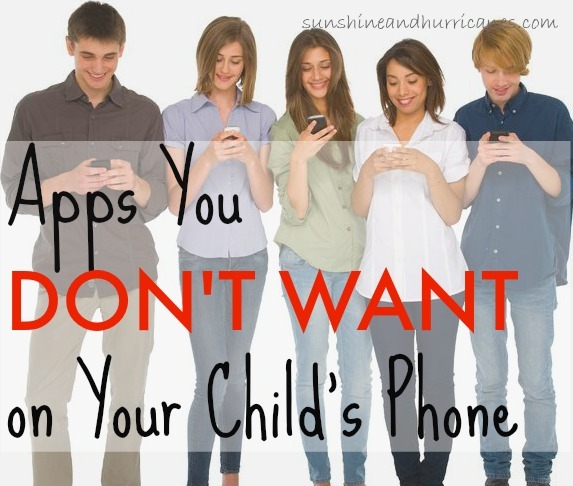The Worst Apps for Kids
Be Sure to Check out the Latest in our Tech for Parents 101 Series: Taking Control of Technology Before Technology Takes Control of Your Family.
While it will be awhile before either of my children get any kind of mobile phone for their own use, I know several of their friends already have them. Since I won’t be able to hold out forever and because I want my children to be educated if they encounter questionable apps on friends devices, I thought I would get ahead of the game with this listing of WORST APPS for kids.
If you’re child already has a phone, you might want to take a look to see if they have any of these already installed on their phone. If so, consider doing a little more research so both you and they can make informed decisions about using them. Also, take care to check the age restrictions listed by most apps before downloading. Many parents are unaware they exist and few of the apps actually have any real age verification process. Want to make sure your kids can’t download ANY apps without your approval…..
1. On an iPhone go into SETTINGS, GENERAL, RESTRICTIONS. You’ll be prompted to create a code and then you can select any phone functions that you don’t want your child to have free access to without your okay.
2. On an Android go into SETTINGS, USERS. Select ADD USER /RESTRICTED PROFILE . You will be prompted to set-up a passcode and then you can choose what they can access on their own and what they’ll need you to enter the passcode to access.
*** HINT*** A speaker I heard recently suggested parents use a “four letter” word as their passcode. It’s something few kids would EVER suspect and it will certainly be easy for you to remember. ![]()
If you want to investigate any app not listed below, a great place to start is at commonsensemedia.org.
Kik
This is an instant messenger/social networking hybrid.Kids can send basic messages like texting, but also photos and files. Since it is used over the internet and anyone can attempt to connect with your child. This app allows kids to send private messages that can be very difficult for parents to access or which can be easily deleted. Since photos are involved, there is considerable opportunity for children to be exposed to inappropriate images. In addition, this is a commonly used app for sexting.
SnapChat
This app allows kids to send photos that once opened by the recipient disappear after 10 seconds. However, should the recipient grab a screen shot of the picture, it is now a permanent image that could easily be shared with others. Most children won’t think about the possibility of the screen shot and may be tempted to take risks sending things that they think will no longer exist after 10 seconds.
Poof (and similar apps)
Poof actually no longer exists, but it represents a whole category of apps that are constantly being created and then deleted, just to pop up as something new. These apps provide the ability to hide apps from being displayed on the phone screen. Therefore, parents who think they are being diligent about monitoring what apps their children are using, may not realize some have been hidden from their view.
Whisper
Whisper’s tag line is “Express Yourself – Share Secrets – Meet New People.” Already this doesn’t sound good for kids, right? Anonymity is the lure of this social meet-up app, where names are never used, but location can be provided within a one mile radius. Again, because kids are online when using it, they are open to anyone who wants to try and connect with them. This is yet another app with picture sharing capabilities as well, making it appealing for both cyber bullying and sexually oriented interaction.
AskFM
A social networking app set-up in a question answer forum that offers complete anonymity and no monitoring whatsoever by the company. This app has already been involved in numerous serious cyber-bullying incidents both in the U.S. and abroad. There is very little ability to control privacy settings and even if your child blocks someone who is harassing them, the individual can still access their profile and view all interactions your child is having on the app.
YikYak
Twitter meets texting with complete anonymity thrown in. A child can send an anonymous message of up to 200 characters and then using GPS, the message can be read by the nearest 500 other people using the app. No images with this one, but it still has gained in popularity quickly and has become a powerful tool for bullying and sexual content.
Vine
Used to make and share short videos, six seconds in length that loop over and over again, this app is actually owned by Twitter. A messaging function has been added since the app launched and those using the app can search based on location. As one would expect with anything that has video capabilities, explicit material is abundantly available and not hard for children to stumble upon. There has also been a trend of teens sharing videos of fights at school. Although Twitter has made some attempt to clean things up, it still is a questionable app for kids and is best used in the presence of parents.
Down
Here’s another with a great slogan – “The anonymous, simple, fun way to find friends who are down for the night.” Operating via a connection with FB, people can group their friends as just buddies or those that they’d like to get “down” with, for a little, well…you know. Those looking for a little, well…you know, can search their friends and see if they can find a match.
Tinder
The flame is a good indicator that this app is a little too hot for a young audience. Yet another hook-up facilitator, anyone using the app can upload their photo and then browse other’s photos indicating “interest” with a heart or a “no way” with a big X. The app will then suggest those nearby who have “hearted” you and if you like them back, a connection is made which enables messaging. I’m sure you can come up with how many ways this could go bad on so many levels without me elaborating any further.
Omegle
Basically chatting with a random stranger, either via standard messaging or with video. For added risk, the app can connect with a Facebook account and then will attempt to connect people using the app to those who have similar “likes”. There is nothing to keep kids from being exposed to inappropriate content and there is ample opportunity for personal information to be shared. When a conversation ends, the chat log can be saved and then a link will be provided that can be shared freely.
Chat Routlette
Combine the randomness of roulette with spontaneous video chat, meaning you never know who you’re going to be paired with or what they might show you. Google it, and you’ll discover that it’s not something anyone should want to be a part of, let alone a young person.
Voxer
I’ll admit, this one sounds kind of cool and I could see it being useful in some situations. This app enables you to transform your mobile phone into a walking talkie. However, beyond just being able to say “over an out”, kids can also exchange photos, texts and other personal information. It’s gotten national attention as part of a high profile cyber bullying case. However, if you want to use it, just make sure you’ve got the location services turned off and privacy settings enabled. Plus, be clear who your child is communicating with when using it.
Looking for more technology and parenting information, be sure to sign up for our newsletter below so you won’t mis any of our future posts in this series. Want to see some of our previous posts related to technology?














